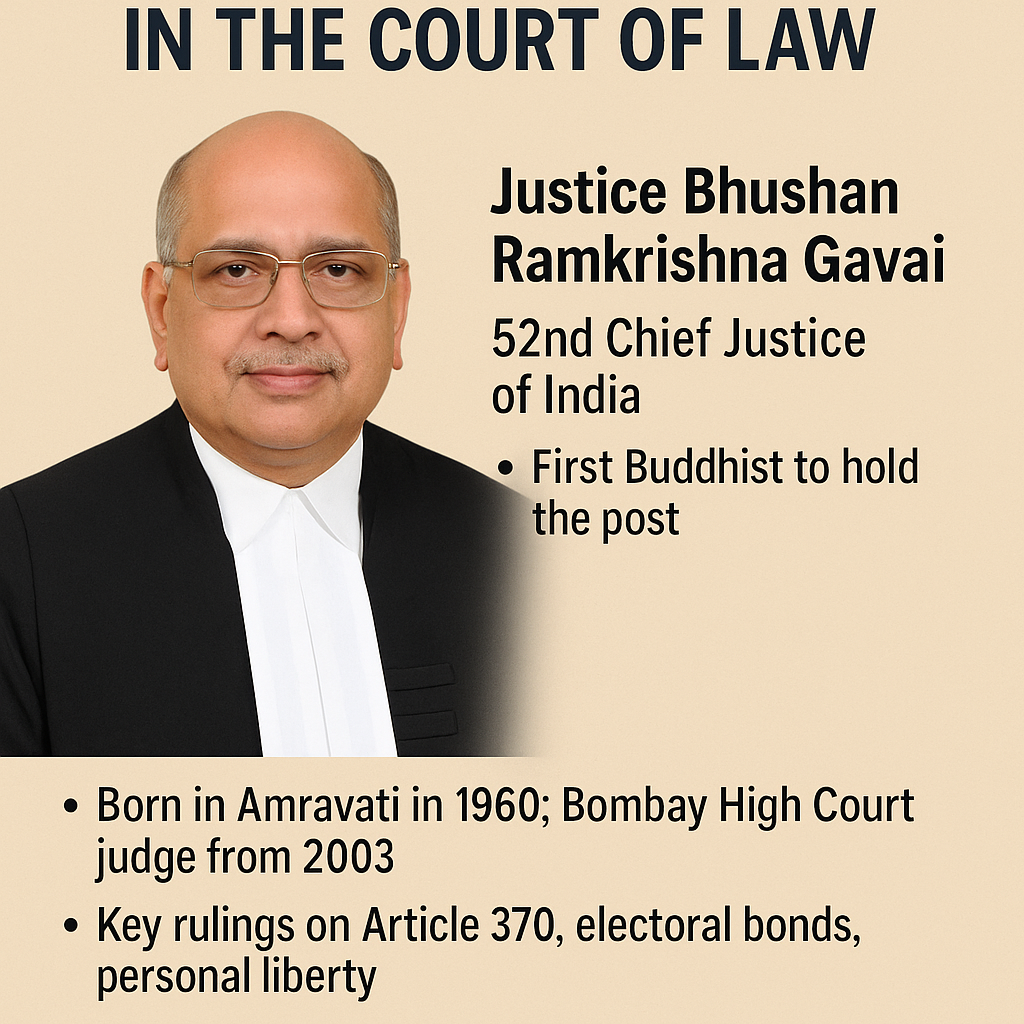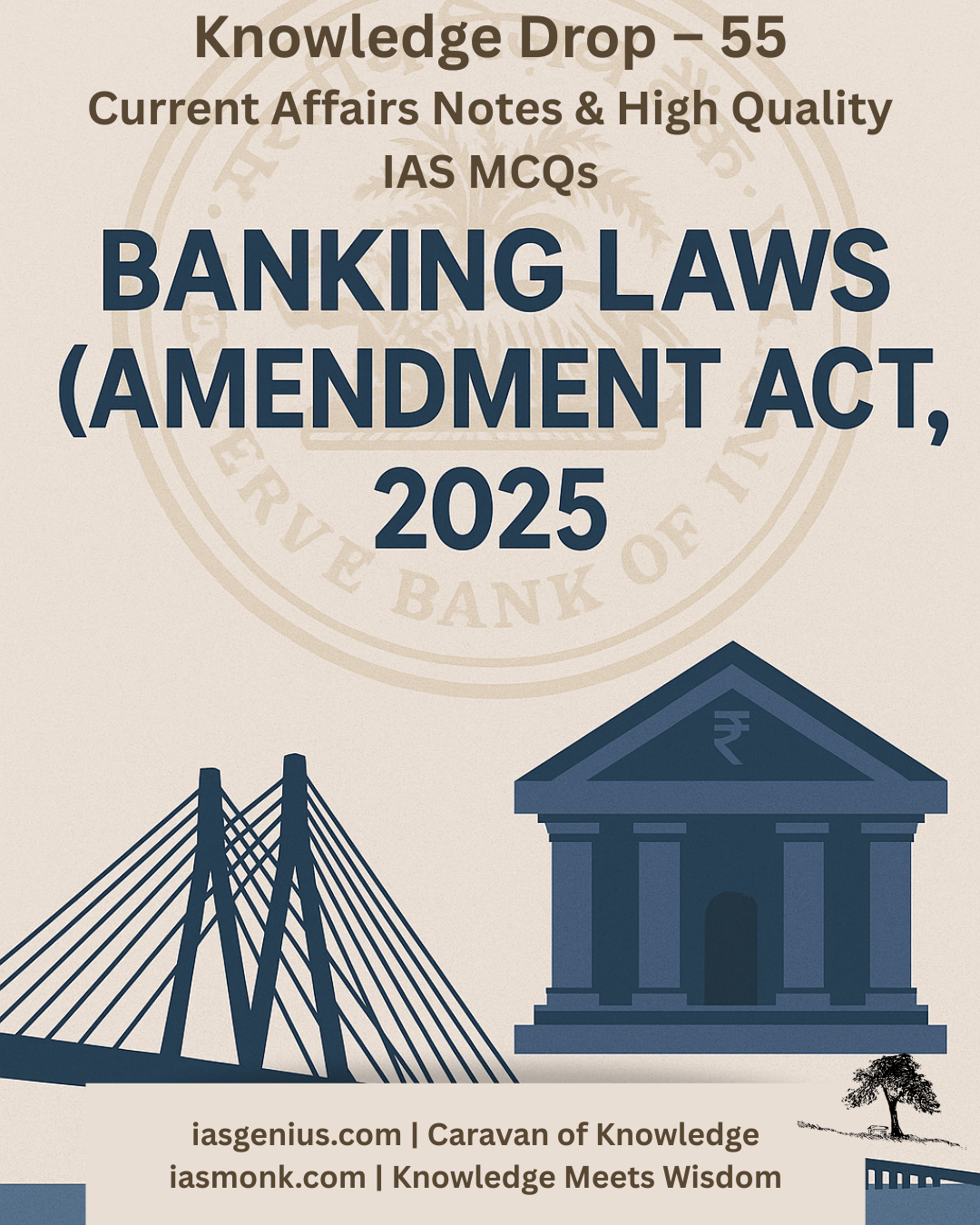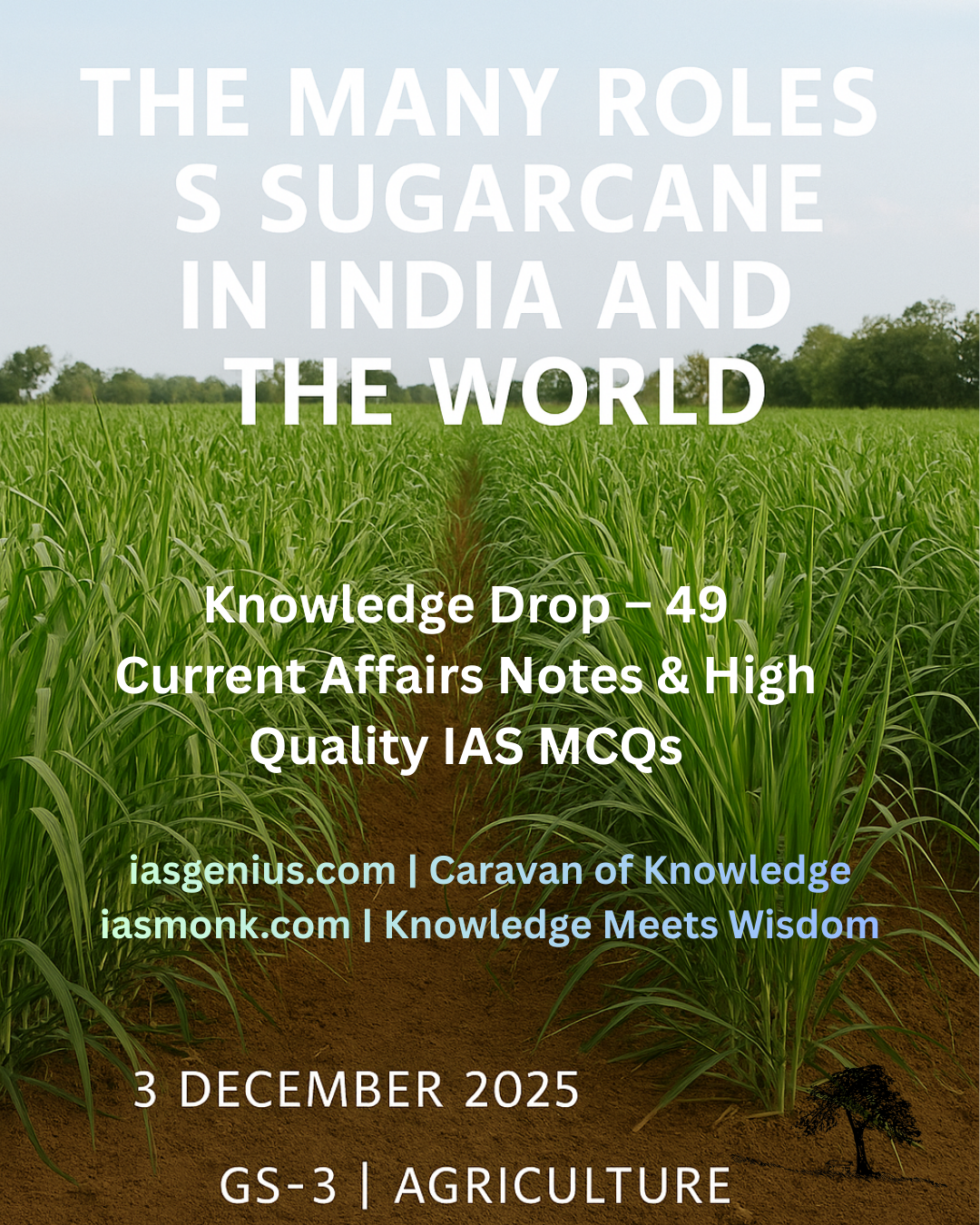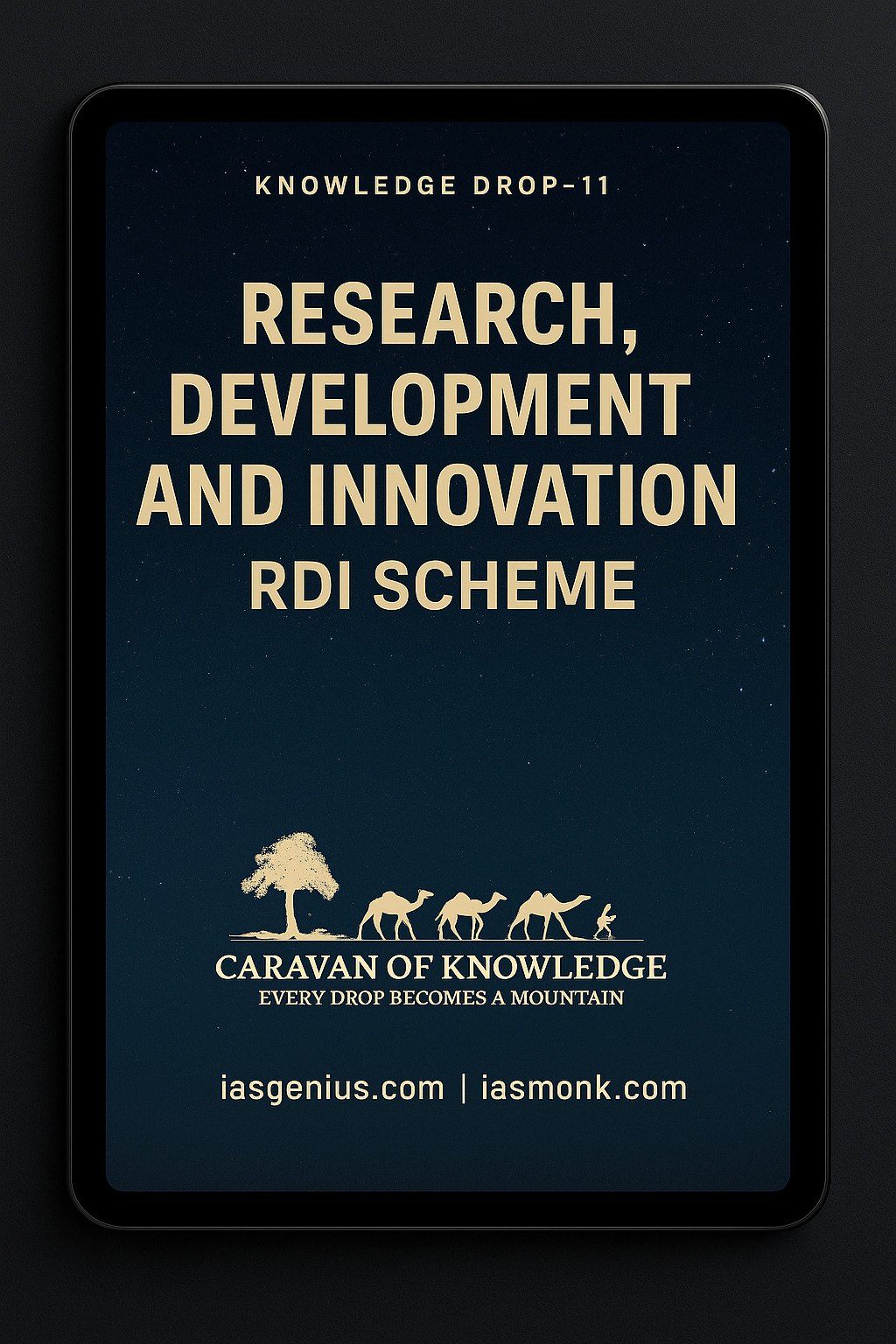
May 16, 2025, Post 2: The Voice of Dharma in the Court of Law |High Quality Mains Essay | Prelims MCQs
The Voice of Dharma in the Court of Law

📅 Date:
May 16, 2025
🎯 Thematic Focus:
Judiciary | Social Justice | Constitutional Law
🕊️ Opening Whisper
A judge carries not just the burden of law, but the unheard murmur of the people’s faith.
🔍 Key Highlights:
- Justice Bhushan Ramkrishna Gavai was sworn in as the 52nd Chief Justice of India at Rashtrapati Bhavan.
- He becomes the first Buddhist and one of the very few Dalit-background justices to hold this post.
- Born in Amravati in 1960, he began his legal career in 1985 and became a Bombay High Court judge in 2003.
- He contributed to key verdicts including:
- Upholding the abrogation of Article 370
- Striking down the Electoral Bonds Scheme
- Defending personal liberty in the Manish Sisodia bail case
- As CJI, he will preside over cases challenging the Places of Worship Act and Waqf (Amendment) Act, 2025.
- His leadership is expected to be assertive, reform-oriented, and socially sensitive.
📘 Concept Explainer: What is the Role of the Chief Justice of India?
The Chief Justice of India (CJI) is the head of the judiciary system and the Supreme Court — the guardian of the Constitution.
Key roles include:
- Allocation of cases and constitution of benches
- Administrative head of the apex court
- Key figure in judicial appointments (via Collegium)
- Symbolic upholder of justice, equality, and constitutional morality
🗺️ GS Paper Mapping:
- GS Paper 2: Structure, Organization and Functioning of the Judiciary
- GS Paper 2: Social Justice and Representation of Marginalized
- GS Paper 1: Modern Indian History — Evolution of Legal Institutions
✨ A Thought Spark — by IAS Monk
When the gavel echoes through the halls of justice, it should not merely announce verdicts, but awaken a collective sense of fairness. Justice Gavai stands not only as a judge, but as a symbol — that in India’s highest temple of law, even the unheard shall be heard.
High Quality Mains Essay For Practice :
Word Limit 1000-1200
From the First CJI, H. J. Kania, to the Present Justice B. R. Gavai: The Evolving Narrative of Indian Jurisprudence
Introduction
The Indian judiciary, a cornerstone of the world’s largest democracy, has undergone a remarkable transformation since Independence. From the early interpretations of the Constitution by Justice H. J. Kania, the first Chief Justice of India, to the ascension of Justice Bhushan Ramkrishna Gavai, the 52nd CJI and the first Buddhist to occupy the post, the Indian Supreme Court has evolved into an institution of immense moral authority. This journey reflects not just a change in personnel, but a shift in constitutional philosophy, judicial activism, inclusivity, and the balance between tradition and transformation.
Justice H. J. Kania and the Birth of Constitutional Jurisprudence
Justice Harilal Jekisundas Kania assumed office on January 26, 1950, the day India’s Constitution came into effect. The early judiciary was characterized by a formalistic and positivist interpretation of the Constitution. The court’s role was seen as that of a neutral umpire, ensuring the letter of the law was followed, without venturing into the domain of policy.
Kania’s landmark decisions, including A. K. Gopalan v. State of Madras (1950), reflected this approach. The majority in that case held that each fundamental right was isolated and had to be read independently. This rigid interpretation placed procedural legality above substantive justice and delayed the flowering of civil liberties jurisprudence.
Nevertheless, the groundwork laid during his tenure provided institutional stability and clarity in jurisdiction — essential in a newly independent nation where the constitutional machinery was still in its infancy.
Judicial Maturity and Expanding Horizons (1950s–1980s)
The decades following Kania saw titans of Indian law like Justices B. K. Mukherjea, M. Hidayatullah, Y. V. Chandrachud, and P. N. Bhagwati, who pushed the boundaries of constitutional interpretation.
The Kesavananda Bharati v. State of Kerala (1973) decision marked a constitutional turning point, establishing the Basic Structure Doctrine, which held that Parliament could not amend fundamental features of the Constitution. This doctrine became a shield against authoritarianism during the Emergency (1975–77), especially after the controversial ADM Jabalpur case, which allowed suspension of habeas corpus.
Post-Emergency, there was a judicial renaissance. Justice Bhagwati pioneered Public Interest Litigation (PIL), turning the court into a protector of marginalized voices. Concepts like right to livelihood, clean environment, education, and prisoner rights were read into Article 21 (Right to Life). This era reflected a growing judicial activism, with courts stepping in where governance had failed.
Constitutional Morality and the Modern Judiciary (1990s–2020s)
The liberalization era brought new challenges — globalization, technology, environmental degradation, identity politics. The court evolved accordingly, attempting to balance economic development with constitutional safeguards.
During the tenure of Chief Justices like K. G. Balakrishnan (first Dalit CJI) and R. M. Lodha, judicial transparency, accountability, and fast-tracking of justice gained prominence. The judiciary also began to adopt progressive liberal jurisprudence — exemplified in Navtej Singh Johar v. Union of India (2018), which decriminalized homosexuality, and Indian Young Lawyers Association v. State of Kerala (2018), which opened Sabarimala temple to women of all ages.
The Supreme Court also upheld privacy as a fundamental right in the landmark Puttaswamy judgment (2017). However, concerns arose around judicial independence, the opaque collegium system, and perceived judicial evasion in politically sensitive cases such as electoral bonds and Article 370 — until they were recently adjudicated.
Justice Bhushan Ramkrishna Gavai: A Symbol of Continuity and Change
The appointment of Justice B. R. Gavai as CJI in May 2025 is both historic and symbolic. Hailing from a Dalit-Buddhist background, his elevation underscores the Indian judiciary’s inclusive evolution — a far cry from its elitist beginnings.
Justice Gavai’s tenure on the bench has already witnessed him delivering or being part of crucial decisions on:
- Abrogation of Article 370 – reaffirming parliamentary supremacy in matters of constitutional reorganization
- Electoral Bonds Verdict – restoring transparency in political funding
- Manish Sisodia bail case – strengthening jurisprudence around personal liberty
As CJI, he inherits pressing constitutional questions — including the challenge to the Places of Worship Act, the Waqf Amendment Act, and potential issues around AI regulation, climate justice, and federalism. His commitment to a collegial and consultative leadership style, as indicated by plans to hold inclusive meetings with judges, signals a judicial temperament rooted in dialogue, not diktat.
Evolution of Judicial Philosophy: From Procedure to Purpose
The journey from Kania to Gavai reveals a profound transformation in judicial philosophy:
- From textual rigidity to purposive interpretation
- From formalism to social justice orientation
- From elite insulation to democratized access (PILs, digitization)
- From opaque proceedings to media scrutiny and public engagement
This has turned the court into both an adjudicator of disputes and a moral conscience of the nation. Yet, the judiciary today also faces challenges of pendency, selective silence, and questions about self-regulation.
Conclusion
The Chief Justices of India, from H. J. Kania to B. R. Gavai, embody the constitutional imagination of India. Their judgments are not just interpretations of law, but markers of India’s social, political, and moral journey. Each CJI has added a distinct hue to the jurisprudential canvas — whether it be structural integrity, liberty, social justice, or inclusion.
Justice Gavai’s tenure marks another chapter in this living tradition — a reminder that in a democracy, the highest court is not only of law, but of conscience. The evolution of Indian jurisprudence, then, is not just about cases and codes, but about voices, values, and the vision of justice in a changing society.
Target IAS-26: Daily MCQs :
📌 Prelims Practice MCQs
Topic:
MCQ 1:Type 1: How many of the above statements are correct?
Consider the following statements regarding the evolution of Indian jurisprudence:
1)Justice H. J. Kania was the first Chief Justice of India and served from the day the Constitution came into force.
2)The Kesavananda Bharati case upheld Parliament’s absolute power to amend the Constitution.
3)Justice P. N. Bhagwati pioneered Public Interest Litigation (PIL) in India.
4)Justice Gavai is the first Buddhist to be appointed as Chief Justice of India.
Which of the above statements are correct?
A) Only two
B) Only three
C) All four
D) Only one
🌀 Didn’t get it? Click here (▸) for the Correct Answer & Explanation
✅ Correct Answer: B) Only three
🧠 Explanation:
B) Only three
1)True – Justice H. J. Kania took office on January 26, 1950.
2)False – The Kesavananda Bharati case limited Parliament’s power by introducing the Basic Structure Doctrine.
3)True – Justice Bhagwati was the key architect of PIL jurisprudence.
4)True – Justice B. R. Gavai is the first Buddhist CJI.
MCQ 2: Type 2: Two-statement check
Consider the following two statements:
1)Justice Gavai was part of the bench that upheld the abrogation of Article 370.
2)He also authored the judgment striking down the Right to Education Act.
Which of the above statements is/are correct?
A) Only 1 is correct
B) Only 2 is correct
C) Both are correct
D) Neither is correct
🌀 Didn’t get it? Click here (▸) for the Correct Answer & Explanation
✅ Correct Answer: A) Only 1 is correct
🧠 Explanation:
• A) Only 1 is correct
1.❌ False – There is no such judgment by him striking down the RTE Act.
2.✅ True – He was on the bench that upheld the abrogation of Article 370.
MCQ 3: Type 3: Which of the following statements is/are correct?
Consider the following statements with respect to the Chief Justice of India (CJI):
1)The CJI is the head of the Indian Judiciary and the Supreme Court.
2)The CJI has no role in judicial appointments and Collegium decisions.
3)The CJI allocates benches and supervises court administration.
4)The tenure of a CJI is fixed at five years.
Select the correct code:
A) 1 and 2 only
B) 1 and 3 only
C) 1, 2 and 3 only
D) 2, 3 and 4 only
🌀 Didn’t get it? Click here (▸) for the Correct Answer & Explanation
✅ Correct Answer: B) 1 and 3 only
🧠 Explanation:
B) 1 and 3 only
1.❌ False – There is no fixed term; it depends on retirement at 65 years.
2.✅ True – The CJI is the top judicial authority in the country.
3.❌ False – The CJI heads the Collegium, which recommends judicial appointments.
4.✅ True – The CJI handles case allocations and overall administration.
MCQ 4 – Type 4: Direct factual
Who among the following was the first Chief Justice of independent India?
A) M. Patanjali Sastri
B) H. J. Kania
C) M. Hidayatullah
D) B. K. Mukherjea
🌀 Didn’t get it? Click here (▸) for the Correct Answer & Explanation.
✅ Correct Answer: B) H. J. Kania
🧠 Explanation:
B) H. J. Kania
1)H. J. Kania was sworn in as the first Chief Justice of India on January 26, 1950.


















